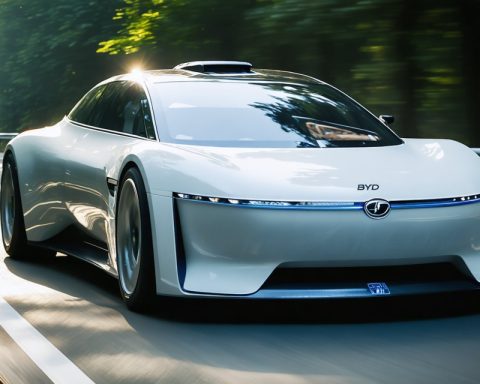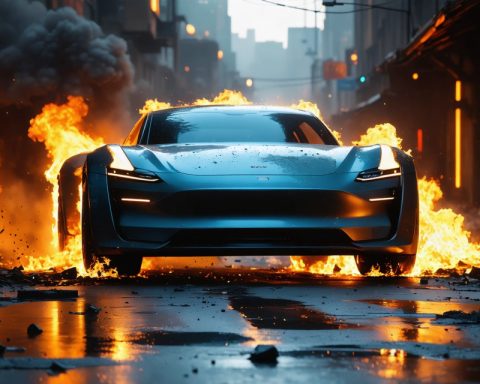- FCL Components Corporation introduces advanced signal-switching relays for electric vehicles, setting new standards in automotive technology.
- Models like FTR-B3, FTR-B4, and FTR-C1 withstand high-voltage surges, enhancing the reliability and safety of EVs.
- The relays support crucial EV functions, including battery monitoring, voltage irregularity detection, and emergency communication.
- Compact design and robust performance allow these components to handle up to 5,000-volt surges.
- Compliant with IATF 16949, RoHS, and ELV standards, these relays ensure passenger and environmental safety.
- Though focused on EVs, these relays are also adaptable for hybrid and gasoline vehicles.
- FCL Components drives innovation in vehicular electronics, merging high reliability with exceptional performance.
Amidst the electric hum of Tokyo’s bustling Shinagawa district, innovation crackles at the heart of FCL Components Corporation. With the swift precision of a samurai’s blade, this Japanese company has carved out a niche in the electrified landscape of automotive technology. The launch of their groundbreaking signal-switching relays offers a glimpse into the future of electric vehicles (EVs).
Imagine the sleek, silent power of an electric vehicle, its heart powered by a high-voltage battery humming with life at 300 to 400 volts DC. They represent not just a technological marvel but also a set of unique challenges. Traditional relays, often the unsung heroes of vehicular signal switching, struggle to hold against the pulse of such high voltages, sometimes cracking under the pressure akin to trying to harness a lightning bolt with a mere umbrella.
Enter FCL Components. With their newly unveiled lineup, including the compact FTR-B3, the streamlined FTR-B4, and the robust FTR-C1, FCL offers a tantalizing solution. Each relay is a tiny titan, engineered to handle the voltage of a Tesla coil with unrivaled grace. These components emerge as essential allies in critical functions from battery monitoring and voltage irregularity detection to emergency calls within the EV’s interior.
The aesthetic of these relays is deceptive. Their small, unassuming form belies the powerful surge they can withstand. For instance, the FTR-B3 and FTR-B4, with a maximum switching power of 0.4W at 400VDC, can resist surges up to 2,500 volts. The FTR-C1 goes a step further amidst its broader insulation distance, bracing against surges of up to 5,000 volts. It’s technology that whispers with elegance yet shields like a warrior’s armor.
Safety, a word carried on the lips of every conscientious driver, finds an ally here. These relays meet the demanding IATF 16949 quality management standard and comply with the stringent European RoHS and ELV directives, ensuring that they not only protect passengers but also the planet.
While initially spotlighted for EVs, these versatile tools extend their capabilities beyond to hybrid and gasoline vehicles as well. The potential to revolutionize the automotive industry echoes within their meticulous design, fostering a future where high-reliability meets high performance seamlessly.
FCL Components isn’t just predicting the future—they’re engineering it. As they continue to expand their formidable array of high-performance relays, they beckon a new era for vehicular electronics, driving safety and reliability to unprecedented heights. This is not simply evolution in motion; it’s the redefinition of what’s possible in automotive tech.
In the ever-evolving dance between innovation and necessity, FCL Components leads with a pirouette of precision, ensuring that every electric journey runs smoothly, safely, and smartly. Here’s to lighting up the road ahead with confidence and control.
Unraveling the Power of FCL Components’ Relays: A Glimpse into the Future of Electric Vehicles
Expanding the Horizons of Electric Vehicle Technology
The automotive industry is on the brink of a transformation, as companies like FCL Components Corporation pioneer advancements designed to meet the challenges of electric vehicles (EVs). Based in Tokyo’s cutting-edge Shinagawa district, FCL Components has introduced groundbreaking signal-switching relays that promise to revolutionize how EVs operate. Here’s a deeper dive into the relays’ capabilities, potential applications, and their future impact on the automotive landscape.
Key Features and Specifications
1. Advanced Relay Models: FCL’s relays, including the FTR-B3, FTR-B4, and FTR-C1, are designed to withstand high voltages and protect critical vehicle functions. These relays handle switching power efficiently, with the FTR-B3 and FTR-B4 managing 0.4W at 400VDC and the FTR-C1 enduring up to 5,000 volts of surge protection.
2. Safety and Compliance: These relays meet the IATF 16949 quality management standards and comply with European RoHS and ELV directives, emphasizing safety and environmental consideration.
3. Versatile Applications: While optimized for EVs, these relays are also suitable for hybrid and traditional gasoline vehicles, suggesting versatility in automotive applications beyond current expectations.
Insights and Predictions
– Future Automotive Trends: Electric vehicles are expected to hold a significant market share by 2030, with relays like FCL’s playing a vital role in addressing electrical challenges. As battery technologies advance, these relays will ensure stability and reliability, crucial for consumer adoption.
– Sustainability Impact: By adhering to stringent regulations, FCL’s relays not only enhance vehicle safety but also contribute to global sustainability efforts. Their compliance with environmental directives emphasizes a commitment to reducing ecological footprints.
Real-World Use Cases
– Battery Management Systems: Optimal for monitoring and regulating battery voltage, these relays can prevent overcharging and enhance battery lifespan, ensuring efficiency in energy use.
– Safety Systems Integration: Used within emergency call systems, these relays ensure communication remains intact during critical situations, an increasingly vital feature in modern vehicles.
– Voltage Stability: In hybrid and gasoline vehicles, they stabilize voltage fluctuations, improving engine performance and reducing wear on crucial components.
Pros and Cons Overview
Pros:
– High voltage endurance
– Compact, efficient design
– Versatility across automotive types
– Compliance with global safety standards
Cons:
– Initial cost may be higher compared to traditional relays
– Niche application limits immediate adaptation in non-EV vehicles
Actionable Recommendations
– For Manufacturers: Consider integrating FCL’s relays into new EV models to enhance performance and reliability. Staying ahead of technological trends ensures competitiveness in a rapidly evolving market.
– For Consumers: When evaluating EVs or hybrids for purchase, inquire about the electrical components. Choosing models with advanced relay systems may offer long-term benefits in safety and reliability.
Conclusion
FCL Components Corporation is at the forefront of innovative vehicle technology, providing solutions that meet current demands and anticipate future needs. As the automotive industry shifts towards electrification, components like those from FCL will be critical in supporting sustainable and safe vehicular technology. Embrace this future-ready technology, lighting up your journey with confidence and control.
For more insights into automotive advancements, visit the Ford website for further updates.
—
This carefully crafted analysis positions FCL Components as a significant player in the electrification of automotive technologies. Keep an eye on this front-runner, as they continue to shape the safety, reliability, and sustainability of transportation.


















